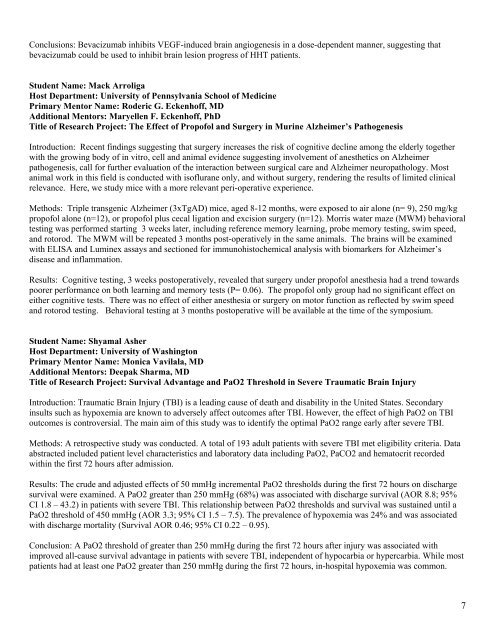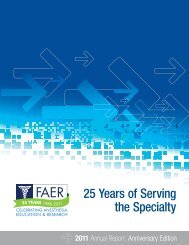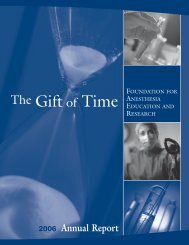2010 MSARF Symposium Participants - Foundation for Anesthesia ...
2010 MSARF Symposium Participants - Foundation for Anesthesia ...
2010 MSARF Symposium Participants - Foundation for Anesthesia ...
Create successful ePaper yourself
Turn your PDF publications into a flip-book with our unique Google optimized e-Paper software.
Conclusions: Bevacizumab inhibits VEGF-induced brain angiogenesis in a dose-dependent manner, suggesting that<br />
bevacizumab could be used to inhibit brain lesion progress of HHT patients.<br />
Student Name: Mack Arroliga<br />
Host Department: University of Pennsylvania School of Medicine<br />
Primary Mentor Name: Roderic G. Eckenhoff, MD<br />
Additional Mentors: Maryellen F. Eckenhoff, PhD<br />
Title of Research Project: The Effect of Propofol and Surgery in Murine Alzheimer’s Pathogenesis<br />
Introduction: Recent findings suggesting that surgery increases the risk of cognitive decline among the elderly together<br />
with the growing body of in vitro, cell and animal evidence suggesting involvement of anesthetics on Alzheimer<br />
pathogenesis, call <strong>for</strong> further evaluation of the interaction between surgical care and Alzheimer neuropathology. Most<br />
animal work in this field is conducted with isoflurane only, and without surgery, rendering the results of limited clinical<br />
relevance. Here, we study mice with a more relevant peri-operative experience.<br />
Methods: Triple transgenic Alzheimer (3xTgAD) mice, aged 8-12 months, were exposed to air alone (n= 9), 250 mg/kg<br />
propofol alone (n=12), or propofol plus cecal ligation and excision surgery (n=12). Morris water maze (MWM) behavioral<br />
testing was per<strong>for</strong>med starting 3 weeks later, including reference memory learning, probe memory testing, swim speed,<br />
and rotorod. The MWM will be repeated 3 months post-operatively in the same animals. The brains will be examined<br />
with ELISA and Luminex assays and sectioned <strong>for</strong> immunohistochemical analysis with biomarkers <strong>for</strong> Alzheimer’s<br />
disease and inflammation.<br />
Results: Cognitive testing, 3 weeks postoperatively, revealed that surgery under propofol anesthesia had a trend towards<br />
poorer per<strong>for</strong>mance on both learning and memory tests (P= 0.06). The propofol only group had no significant effect on<br />
either cognitive tests. There was no effect of either anesthesia or surgery on motor function as reflected by swim speed<br />
and rotorod testing. Behavioral testing at 3 months postoperative will be available at the time of the symposium.<br />
Student Name: Shyamal Asher<br />
Host Department: University of Washington<br />
Primary Mentor Name: Monica Vavilala, MD<br />
Additional Mentors: Deepak Sharma, MD<br />
Title of Research Project: Survival Advantage and PaO2 Threshold in Severe Traumatic Brain Injury<br />
Introduction: Traumatic Brain Injury (TBI) is a leading cause of death and disability in the United States. Secondary<br />
insults such as hypoxemia are known to adversely affect outcomes after TBI. However, the effect of high PaO2 on TBI<br />
outcomes is controversial. The main aim of this study was to identify the optimal PaO2 range early after severe TBI.<br />
Methods: A retrospective study was conducted. A total of 193 adult patients with severe TBI met eligibility criteria. Data<br />
abstracted included patient level characteristics and laboratory data including PaO2, PaCO2 and hematocrit recorded<br />
within the first 72 hours after admission.<br />
Results: The crude and adjusted effects of 50 mmHg incremental PaO2 thresholds during the first 72 hours on discharge<br />
survival were examined. A PaO2 greater than 250 mmHg (68%) was associated with discharge survival (AOR 8.8; 95%<br />
CI 1.8 – 43.2) in patients with severe TBI. This relationship between PaO2 thresholds and survival was sustained until a<br />
PaO2 threshold of 450 mmHg (AOR 3.3; 95% CI 1.5 – 7.5). The prevalence of hypoxemia was 24% and was associated<br />
with discharge mortality (Survival AOR 0.46; 95% CI 0.22 – 0.95).<br />
Conclusion: A PaO2 threshold of greater than 250 mmHg during the first 72 hours after injury was associated with<br />
improved all-cause survival advantage in patients with severe TBI, independent of hypocarbia or hypercarbia. While most<br />
patients had at least one PaO2 greater than 250 mmHg during the first 72 hours, in-hospital hypoxemia was common.<br />
7





